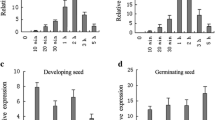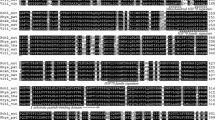Abstract
Heat stress in plants elevates the potential across the inner mitochondrial membrane (mtΔψ) and activates the expression of heat shock proteins (HSPs). The treatment of Saccharomyces cerevisiae cells with amiodarone (AMD) elevated the cytosolic Ca2+ level ([Ca2+]cyt) in parallel with (mtΔψ) increase and led to the induction of Hsp104 synthesis. The hyperpolarization was presumably due to the increase in [Ca2+]cyt. In the present study the effects of AMD (0–100 μM) on cell viability, HSP expression, mtΔψ, and [Ca2+]cyt were investigated using the cell culture of Arabidopsis thaliana (L.) Heynh. The treatment of cultured cells with AMD led to the elevation of [Ca2+]cyt, which was accompanied by the increase in mtΔψ and by activation of HSP101 expression. The increase in [Ca2+]cyt and expression of HSP101 were also observed upon the treatment with the protonophore CCCP (carbonyl cyanide m-chlorophenylhydrazone, 4 μM) known to diminish mtΔψ. The results suggest that plant cell mitochondria modulate the cytosolic Ca2+ level by changing the potential at the inner mitochondrial membrane and, thereby, participate in the retrograde regulation of HSP101 expression.
Similar content being viewed by others
Abbreviations
- AMD:
-
amiodarone (2-butyl-3-(3,5-diiodo-4-diethylaminoethoxybenzoyl) benzofuran)
- CCCP:
-
carbonyl cyanide m-chlorophenylhydrazone
- FDA:
-
fluorescein diacetate
- HSP:
-
heat shock protein
- JC:
-
1-5,5′,6,6′-tetrachloro-1,1′,2,2′-tetraethyl-benzimidazol-carbocyanine
- mtΔϖ:
-
potential across the inner mitochondrial membrane
- PI:
-
propidium iodide
- RT:
-
PCR-reverse transcription polymerase chain reaction
- SE:
-
standard error
- TTC:
-
2,3,5-triphenyltetrazolium chloride
- [Ca2+]mit:
-
concentration of mitochondrial Ca2+
- [Ca2+]cyt:
-
concentration of cytosolic Ca2+
References
Millar, A.H., Whelan, J., Soole, K.L., and Day, D.A., Organization and regulation of mitochondrial respiration in plants, Annu. Rev. Plant Biol., 2011, vol. 62, pp. 79–104.
Yurina, N.P. and Odintsova, M.S., Signal transduction pathways of plant mitochondria: retrograde regulation, Russ. J. Plant Physiol., 2010, vol. 57, pp. 7–19.
Saidi, Y., Finka, A., and Goloubinoff, P., Heat perception and signaling in plants: a tortuous path to thermotolerance, New Phytol., 2011, vol. 190, pp. 556–565.
Subbaiah, C.C., Bush, D.S., and Sachs, M.M., Mitochondrial contribution to the anoxic Ca2+ signal in maize suspension-cultured cells, Plant Physiol., 1998, vol. 118, pp. 759–771.
Logan, D. and Knight, M.R., Mitochondrial and cytosolic calcium dynamics are differentially regulated in plants, Plant Physiol., 2003, vol. 133, pp. 21–24.
Schwarzländer, M., Fricker, M.D., and Sweetlove, L.J., Monitoring the in vivo redox state of plant mitochondria: effect of respiratory inhibitors, abiotic stress and assessment of recovery from oxidative challenge, Biochim. Biophys. Acta, 2009, vol. 1787, pp. 468–475.
Krause, M. and Durner, J., Harpin inactivates mitochondria in Arabidopsis suspension cells, Mol. Plant-Microbe Interact., 2004, vol. 17, pp. 131–139.
Banti, V., Mafessoni, F., Loreti, E., Alpi, A., and Perata, P., The heat-inducible transcription factor HsfA2 enhances anoxia tolerance in Arabidopsis, Plant Physiol., 2010, vol. 152, pp. 1471–1483.
Kuzmin, E.V., Karpova, O.V., Elthon, T.E., and Newton, K.J., Mitochondrial respiratory deficiencies signal up-regulation of genes for heat shock proteins, J. Biol. Chem., 2004, vol. 279, pp. 20 672–20 677.
Kim, M., Lee, U., Small, I., des Francs-Small C.C., and Vierling, E., Mutations in an Arabidopsis mitochondrial transcription termination factor-related protein enhance thermotolerance in the absence of the major molecular chaperone HSP101, Plant Cell, 2012, vol. 24, pp. 3349–3365.
Rikhvanov, E.G., Varakina, N.N., Rusaleva, T.M., Rachenko, E.I., Knorre, D.A., and Voinikov, V.K., Do mitochondria regulate the heat-shock response in Saccharomyces cerevisiae? Curr. Genet., 2005, vol. 48, pp. 44–59.
Rikhvanov, E.G., Gamburg, K.Z., Varakina, N.N., Rusaleva, T.M., Fedoseeva, I.V., Tauson, E.L., Stupnikova, I.V., Stepanov, A.V., Borovskii, G.B., and Voinikov, V.K., Nuclear-mitochondrial cross-talk during heat shock in Arabidopsis cell culture, Plant J., 2007, vol. 52, pp. 763–778.
Balogh, G., Horvath, I., Nagy, E., Hoyk, Z., Benko, S., Bensaude, O., and Vigh, L., The hyperfluidization of mammalian cell membrane acts as a signal to initiate the heat shock protein response, FEBS J., 2005, vol. 272, pp. 6077–6086.
Korshunov, S.S., Skulachev, V.P., and Starkov, A.A., High protonic potential actuates a mechanism of production of reactive oxygen species in mitochondria, FEBS Lett., 1997, vol. 416, pp. 15–18.
Robb-Gaspers, L.D., Burnett, P., Rutter, G.A., Denton, R.M., Rizzuto, R., and Thomas, A.P., Integrating cytosolic calcium signals into mitochondrial metabolic responses, EMBO J., 1998, vol. 17, pp. 4987–5000.
Gupta, S.S., Ton, V.K., Beaudry, V., Rulli, S., Cunningham, K., and Rao, R., Antifungal activity of amiodarone is mediated by disruption of calcium homeostasis, J. Biol. Chem., 2003, vol. 278, pp. 28 831–28 839.
Pozniakovsky, A.I., Knorre, D.A., Markova, O.V., Hyman, A.A., Skulachev, V.P., and Severin, F.F., Role of mitochondria in the pheromone- and amiodarone-induced programmed death of yeast, J. Cell Biol., 2005, vol. 168, pp. 257–269.
Fedoseeva, I.V., Pyatrikas, D.V., Varakina, N.N., Rusaleva, T.M., Stepanov, A.V., Rikhvanov, E.G., Borovskii, G.B., and Voinikov, V.K., Effect of amiodarone on thermotolerance and Hsp104p synthesis in the yeast Saccharomyces cerevisiae, Biochemistry (Moscow), 2012, vol. 77, pp. 78–86.
Enikeev, A.G., Vysotskaya, E.F., Leonova, L.A., and Gamburg, K.Z., Viability assay with 2,3,5-triphenyltetrazolium chloride in plant cell cultures, Russ. J. Plant Physiol., 1995, vol. 42, pp. 372–375.
Reape, T.J., Molony, E.M., and McCabe, P.F., Programmed cell death in plants: distinguishing between different modes, J. Exp. Bot., 2008, vol. 59, pp. 435–444.
Lowry, O.H., Rosebrough, N.I., Farr, A.L., and Randell, R.J., Protein measurement with the Folin phenol reagent, J. Biol. Chem., 1951, vol. 193, pp. 265–275.
Timmons, T.M. and Dunbar, B.S., Protein blotting and immunodetection, Methods Enzymol., 1990, vol. 182, pp. 679–701.
Roy, S.S. and Hajnóczky, G., Calcium, mitochondria and apoptosis studied by fluorescence measurements, Methods, 2008, vol. 46, pp. 213–223.
Lemasters, J. and Ramshesh, V., Imaging of mitochondrial polarization and depolarization with cationic fluorophores, Methods Cell Biol., 2007, vol. 80, pp. 283–295.
Paredes, R.M., Etzler, J.C., Watts, L.T., and Lechleiter, J.D., Chemical calcium indicators, Methods, 2008, vol. 46, pp. 143–151.
Queitsch, C., Hong, S.W., Vierling, E., and Lindquist, S., Heat shock protein 101 plays a crucial role in thermotolerance in Arabidopsis, Plant Cell, 2000, vol. 12, pp. 479–492.
Biyasheva, A.E., Molotkovskii, Yu.G., and Mamonov, L.K., Increase of free Ca2+ level in cytosol of plant protoplasts under heat stress: the relation with Ca2+ homeostasis, Russ. Plant Physiol., 1993, vol. 40, pp. 613–618.
Maresova, L., Muend, S., Zhang, Y.Q., Sychrova, H., and Rao, R., Membrane hyperpolarization drives cation influx and fungicidal activity of amiodarone, J. Biol. Chem., 2009, vol. 284, pp. 2795–2802.
Kader, M.A. and Lindberg, S., Cytosolic calcium and pH signaling in plants under salinity stress, Plant Signal Behav., 2010, vol. 5, pp. 233–238.
Denton, R.M., Regulation of mitochondrial dehydrogenases by calcium ions, Biochim. Biophys. Acta, 2009, vol. 1787, pp. 1309–1316.
Author information
Authors and Affiliations
Corresponding author
Additional information
Original Russian Text © D.V. Pyatrikas, E.G. Rikhvanov, I.V. Fedoseeva, N.N. Varakina, T.M. Rusaleva, E.L. Tauson, A.V. Stepanov, G.B. Borovskii, V.K. Voinikov, 2014, published} in Fiziologiya Rastenii, 2014, Vol. 61, No. 1, pp. 88–98.
Rights and permissions
About this article
Cite this article
Pyatrikas, D.V., Rikhvanov, E.G., Fedoseeva, I.V. et al. Mitochondrial retrograde regulation of HSP101 expression in Arabidopsis thaliana under heat stress and amiodarone action. Russ J Plant Physiol 61, 80–89 (2014). https://doi.org/10.1134/S1021443714010117
Received:
Published:
Issue Date:
DOI: https://doi.org/10.1134/S1021443714010117




